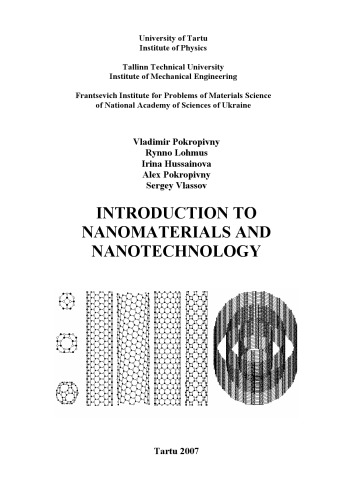Product desciption
Introduction To Nanomaterials And Nanotechnology Vladimir Pokropivny by Vladimir Pokropivny, Rynno Lohmus, Irina Hussainova, Alex Pokropivny, Sergey Vlassov 9789949117413, 9949117410 instant download after payment.
Special lecture course for bachelors, MSc, post-graduates and specialists in nanotechnology.
Physics and chemistry of nanostructures or nanophysics and nanochemistry are
relatively new areas of science arisen in last decade of past century after discovery of
fullerenes and nanotubes. It is introduction into more extent interdisciplinary integrated
modern science known now as nanotechnology rapidly developing. At this stage of
growing knowledge authors have shortly outlined the subject and classifications of
nanostructures, interesting milestones, main principles, methods, techniques, as well as
general directions of future perspective research to be a guideline in a see of modern
research. Main mechanisms of physico-chemical processes affected formation of
nanostructured materials and their properties are clearly expressed, in particular, a
dielectric permittivity as a principal characteristic of electric, magnetic, acoustic, optic
transparency, superconducting, and other properties of nanoceramics and nanometals.
The peculiar properties of nanostructures are emphasized to be result of size effects,
external and internal, classical and quantum ones, that arise in zero-dimensional
quantum dots, one-dimensional wires, and two-dimensional layers. Numerous
applications are considered including microlasers, photonic crystals, probe microscopy,
left-handed materials with negative refraction index, etc. Novel idea is advanced that
new discovery of novel fundamental laws, phenomena and applied effects are possible
only in artificially fabricated nanostructures with new effect theoretically predicted and
designed in advance. Content of the course covers the types, classification and
peculiarities of nanostructures, size effects, synthesis and growth, fullerenes, nanotubes,
microlasers, photonics, scanning probe microscopy, nanomanipulation, etc. The course
is based on the lectures given during several years for students of Kiev National
University (Ukraine), Tartu University and Tallinn Technical University (Estonia).
RAK/NSF Meede 1.1 Project has supported this work. Also Estonian Science foundation grants no. 6658,6537, 6660 and Ukraine Nanotechnology Science Foundation. Estonian Nanotechnology Competence Center projects were also engaged to this work


